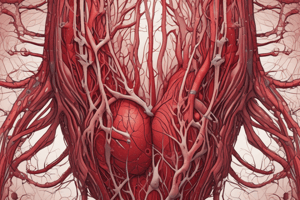Podcast
Questions and Answers
What is hemostasis?
What is hemostasis?
The process of stopping the loss of blood from an injured blood vessel.
Which chemical released by platelets causes vasoconstriction in injured blood vessels?
Which chemical released by platelets causes vasoconstriction in injured blood vessels?
Serotonin
What attracts platelets to the injured site to form a hemostatic plug?
What attracts platelets to the injured site to form a hemostatic plug?
Exposed collagen
What does ADP do in the process of forming a hemostatic plug?
What does ADP do in the process of forming a hemostatic plug?
Which enzyme catalyzes the conversion of fibrinogen to fibrin?
Which enzyme catalyzes the conversion of fibrinogen to fibrin?
What stabilizes the loose mesh of fibrin strands into a tight structure?
What stabilizes the loose mesh of fibrin strands into a tight structure?
What is the normal bleeding time using Duke's method?
What is the normal bleeding time using Duke's method?
What cells or platelets release thromboplastin?
What cells or platelets release thromboplastin?
What forms the final stable clot in the sequence of clotting events?
What forms the final stable clot in the sequence of clotting events?
What is the role of calcium ions in blood clotting?
What is the role of calcium ions in blood clotting?
Flashcards are hidden until you start studying
Study Notes
Hemostasis
- Hemostasis is the process of stopping blood loss from an injured blood vessel.
- It involves a series of events to stop bleeding.
Local Vasoconstriction of Blood Vessel
- When a blood vessel is injured, platelets release serotonin, a strong vasoconstrictor.
- Serotonin causes constriction of blood vessel muscles, narrowing the vessel's diameter and reducing blood loss.
Formation of the Temporary Hemostatic Plug
- When the blood vessel is injured, the endothelium is disturbed, and collagen is exposed.
- Platelets adhere to the collagen, releasing serotonin and ADP, which attracts more platelets.
- The platelets form a white plug (hemostatic plug) that reduces temporary blood loss.
Clotting Formation
- Clot formation occurs in the plasma by converting soluble fibrinogen to insoluble fibrin.
- Fibrin forms a loose mesh of strands that is then converted to a tight structure by factor XIII and calcium.
- Thrombin catalyzes the conversion of fibrinogen to fibrin.
Bleeding Time: Duke's Method
- Bleeding time measures the primary phase of hemostasis, the interaction of platelets with the hemostatic plug.
- The normal value of bleeding time is 1-3 minutes.
- It is used to detect platelet and vascular abnormalities.
Procedure for Bleeding Time
-
Clean the finger with alcohol and dry it with cotton.
-
Use the following chemical reactions to understand the process:
-
Damaged platelets or tissue cells release thromboplastin.
-
Prothrombin + Calcium ions → Thrombin.
-
Fibrinogen + Calcium ions → Fibrin.
-
Fibrin + cells → Clot.
Studying That Suits You
Use AI to generate personalized quizzes and flashcards to suit your learning preferences.




